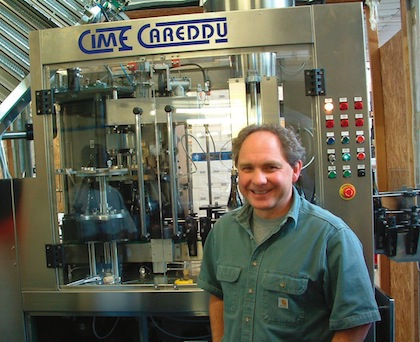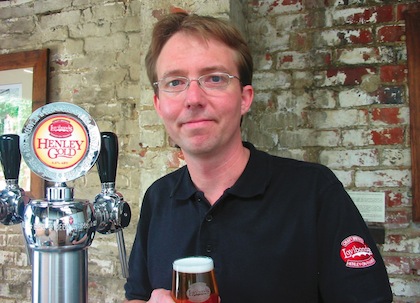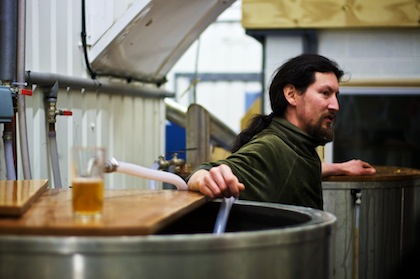What’s in a name? Everything it seems when it comes to casks and kegs in Britain.
Nowadays, exponents of craft keg, using updated technologies, urge drinkers to forget the past and judge their new beers on taste and not on how they are dispensed. And it may be working.
In the last year or so, a select crew of beer fans and brewers has begun proselytizing about what they regard as British beer’s cutting edge—craft keg. But the word keg sends shivers down the backs of members of the Campaign for Real Ale (CAMRA) who believe in traditional beer or cask-conditioned beer, which they call real ale.

Meantime Brewing Company's founder and brewmaster Alastair Hook. (photo courtesy of Meantime Brewing Co.)
Draft beer traditionally had been put into a cask with enough yeast to create a secondary fermentation and is dispensed with a hand pump. It is unpasteurized and unfiltered.
But by the early 1970s, much of the beer served in Britain was from kegs. The beer was filtered and pasteurized and carbon dioxide was used to dispense it. The advantage over the casks was that there was no sediment in the beer, but the disadvantage was that there was more gas in keg beer, which some believe diluted the natural flavour.
This is when CAMRA was created and helped partially reverse the momentum of kegs and preserve natural beers in Britain.
Nowadays, exponents of craft keg, using updated technologies, urge drinkers to forget the past and judge their new beers on taste and not on how they are dispensed. And it may be working.
Spotting a Trend
Craft beer is enjoying a healthy state of affairs in the United Kingdom. There are nearly 800 breweries, mainly micro in size, and many are showing growth. There is a multitude of beer styles available and New World hops have never been more popular.
Social media has also helped as brewers, beer journalists and beer geeks have taken to the blogosphere to discuss beer.
And 2011 saw more craft beer bars open. Then there is the influence of the North American beer scene.
Sierra Nevada’s Pale Ale and Brooklyn Lager are commonly seen in bars on draft (in other words keg!), while brewers such as Odell Brewing Co., Flying Dog and Brooklyn Brewery visit from across the Atlantic and organize tastings.
And the emergence of United Kingdom craft lager brewers—see AAB, Vol 31, Number 4—has persuaded brewers that beer can be dispensed in other ways than by hand pump and still taste good.
“I find all sorts of people trying craft keg,” said Glyn Roberts, former manager of The Rake, arguably London’s first craft beer bar when it opened in 2005, “Not just young people, but older drinkers too. I have a feeling that it will keep its momentum partly because many people like drinking cold fizzy beer and partly because more craft breweries are using keg as a form of dispense.
“I believe that there are a couple of reasons for the latter. Firstly the beer keeps longer and is more robust… Secondly I think that there’s an element of emulating the U.S. where there is very little cask dispense.”
In Greenwich, Meantime Brewery’s founder and brewmaster Alastair Hook could be forgiven a slight self-congratulatory smile at craft keg’s emergence. When he began Meantime in 1999, every new brewery majored in cask beer. But Munich-trained Hook specialized in European beer styles such as helles, pilsner and Vienna.
British styles such as IPA, porter, stout and pale ale were eventually brewed, all of which are dispensed from kegs or bottle. “It’s been a tough battle,” he said, “but there have been a lot of changes in the last five years and I take a lot of pride in thinking that we have helped in many ways to inspire other brewers.”
But Hook is quick to state that Meantime is not opposed to real ale. One of the company’s best customers is the Market Porter, a South London pub noted for serving up to a dozen real ales. For Hook good beer is a simple matter of technology plus the absence of air from the beer container. “Air is bad for beer and the only people who don’t understand that are those who believe that cask is the only way,” he said.
“If cask conditioning is done properly, you have a re-conditioning in the cask, which should work really well. But if the cask is left hanging about for too long, it is not good for it. We have cask beers in our bars. We should only be talking about good beer.”
Making the Switch
One brewer inspired by Hook is Jeff Rosenmeier. He moved to Britain from the United States in the 1990s to work in software engineering but was also an avid homebrewer. He swapped bytes for beer in 2005 when he started Lovibonds in Henley (formerly home to Brakspear’s). Even though cask beer was initially brewed, he soon switched to bottles and kegs.
“All the local micros did cask beer so I thought I would have to do it as well,” he said. “I was a true nano brewery at the time, doing 100-liter batches and I bought a dozen firkins. I started selling these to my local free house and discovered that at day four in the pub the beer that I worked so hard to produce tasted flat, lifeless and was starting to sour.

Lovibonds Brewery's Jeff Rosenmeier, founder and brewmaster, has been brewing on the historic Henley-on-the-Thames since 2005.
He said he was aware of what Hook was doing and it made sense to him and gave him confidence to try something different.
Tasting through his portfolio of beers, you get a sense of his eclectic approach.
Henley Gold is a wheat beer that seemingly owes more to Flanders than Bavaria. There are bananas and cloves on the nose, along with a brittle herby/spicy background. The mouth-feel is creamy and caressing and the palate is suggestive of ripe bananas, accompanied by a medicinal aniseed-like note; the finish is dry and slightly woody.
Henley Dark has a lustrous, silky texture, reminiscent of chocolate ice cream, along with some smokiness, delicate roast notes and mocha coffee. At the back of the throat there is a hint of orange. Served cold and crisp from the keg, it has a refreshingly frisky nature. It’s a party beer, a cheerful, bright-eyed beer and I couldn’t help reflect that dark beers in the cask often seem more somber. These were good beers and if I hadn’t been told, I wouldn’t have known they were dispensed from kegs.
“It is funny to watch all of the brainpower and bytes wasted on the debate about what is ‘real’ or not,” said Rosenmeier, “and I’m as guilty as anyone. But, the fact of the matter is that 99 percent of the British beer-drinking public don’t care whether a beer is dispensed with extraneous CO2 or whether or not a cask breather (where a layer of CO2 keeps oxygen from contact with the beer) has been employed. All they care about is if the beer tastes good and they feel they are getting value for their money.
“We don’t do any filtration or pasteurisation or any other voodoo; therefore the beer that we package always contains yeast. To me it is still a live product. Where we fall down with CAMRA is with dispense, as all of our beers are pushed to the bar with CO2. The only by-product of us using CO2 is that our beer can last months in a cold cellar. Our bottled beers are also not filtered, however we keep the yeast counts low so that we don’t get the chunky style beer like most real ales.”
Every Dog has its Day
One brewery that has certainly set up craft keg as a superior alternative to real ale is Scotland’s iconoclastic BrewDog. These self-proclaimed punks have been masters of public relations with stunts such as brewing the strongest beer in the world, encouraging fans to invest in the business and engaging in online spats with CAMRA.
However, they also have managed to produce a stunning set of beers (plus some duds as well). They initially produced their beers in bottles and casks but with the opening of their branded bars in Aberdeen and Edinburgh (with London and other cities imminent), they have become vocal champions of the craft keg.
“We always believed kegs were the future,” said James Watt, BrewDog’s co-founder. “Cask is traditional to the U.K. and does well at showcasing some pretty boring beers in a way to make them seem a little bit more interesting. However the U.K. cask scene is also traditional, stuffy and old-fashioned with CAMRA’s overbearing influence making the whole thing very strange.
“We wanted to get away from all that and get new drinkers into the craft beer category and we see kegs as the way to do this. If we look at the U.S. craft beer scene, it is kegs that are leading the way. The same thing will happen in the U.K.”
But it’s also instructive to talk to more conventional, brewers. They often see craft keg as another product in their beer arsenal. They make real ale and sell a lot of it, but craft keg’s longer shelf life gives them a chance to get into outlets where real ale might not appear.
“Keg beer opens up a whole new trade customer base,” said Bob Hogg, Commercial Manager of Scottish brewery Inveralmond. “This is particularly true in a relatively small market like Scotland. Keg beer also gives us an opportunity to reach consumers who may not necessarily choose real ale first. As for the name craft keg, I don’t really mind what it is called as long as it is good beer—good beer can be served in keg format as well as cask. We are finding pub owners quite prepared to try something new as they realize that having a point of difference can help drive footfall to their pub, whether it be cask, craft keg or a combination of both.”
Inveralmond initially began with a Czech-style svetly lezak called Sunburst, which originally had been served as a “cask-conditioned” lager. Then it was kegged and served colder with more CO2. Following this, the brewery then felt it could do the same with Lia Fail, a dark chestnut ale with mocha coffee, chocolate, vanilla and espresso notes on the palate. The beer is chill conditioned for two weeks at minus 1 degree C prior to filtration with the addition of some CO2.
There are some problems with keg beer and one is getting it to the market. More investment is needed for keg beer than for casks, for example some pubs require font and chilling equipment for the kegs.
New Craft Keg Brewery
Close to the Rake in London is an exciting new wave brewery whose approach typifies the eclectic nature of the craft keg. The Kernel Brewery is beneath a railway arch in the Bermondsey district of south London, an area that was flattened during the 1940/41 London Blitz.
Started by Evin O’Riordain in 2009, its beers are mainly bottled with the rest in casks and kegs for brewery open house on Saturdays.
According to O’Riordain, “We have been approached by lots of pubs for kegs, so it would seem that the demand is there. Our beer suits bottles and it may suit kegs as well, but for us keg conditioning is more difficult than bottle conditioning. It requires more equipment, and the kegs require more looking after and are harder for pubs to serve well. We reckon that certain beers, for example our IPAs, work brilliantly in keg, and not so well in cask.”
At the brewery, I try a glass of the 7.8 percent Export Stout, dispensed from a keg. It is full of espresso, roast coffee beans, milk chocolate on the nose; the mouth-feel has a rich chocolaty texture with a firm bitterness and a dry cracker-like finish that has delicate fruity notes in the background. It is magnificent.
Kernel is new but other more established breweries, known for their cask beer, are looking to include craft kegs in their portfolio. These include Titanic (whose keg stout replaced a well-known Irish brand at the bar counter in one pub I visited); Fuller’s (its keg London Porter is gorgeous); Butcombe; and cutting-edge Welsh brewery Otley.
“We are trialing three of our beers in keg,” said brewery founder Nick Otley, “The Oxymoron Black IPA, 07 Weissen and Motley Brew IPA. We’re confident that the finished keg product will also be a good match with certain food, but we are only doing it on a small scale at the moment and will not be investing too much in it. Keg will never replace cask. Cask is unique to the U.K. and should remain so. I certainly don’t want my only choice in a pub to be cold and fizzy, but there is definitely room for it as an alternative.”
Otley’s words are also echoed by the Stuart Howe, head brewer at Sharp’s, recently purchased by Molson-Coors.
“It is not an area I think I will be entering in the near future,” he tells me, “From a brewer’s perspective, keg is good because you can use higher levels of CO2 to provide balance for fuller beers with bigger alcoholic strengths. On the downside, unless you are filling kegs with unprocessed beers, centrifugation, filtration and/or pasteurization of beer for kegging does change beer flavour from that you can experience in the brewery. Cask ale is as close as you can get to drinking it from a tank in the brewery.”
If there was one thing that demonstrated craft keg’s arrival it was the debut appearance of the Craft Beer in Keg awards category at the Society of Independent Brewers (SIBA) National Beer Competition in 2011. This was groundbreaking given that the vast majority of SIBA members produce cask beer.
I judged this category and found it thoroughly intriguing. It was divided into lager styles, wheat beers, stouts and porters and a variety of ales. There were good beers, plus a few indifferent chaps.
Thornbridge’s Kipling, a self-proclaimed South Pacific Pale Ale, had a big biff of passion fruit on the nose, but little else. I love it when served on cask. While Hambleton’s Nightmare, a gorgeous stout that has won plenty of awards in cask, was all butter toffee and mocha on the nose and thin roast water on the palate.
On the other hand, Thornbridge’s Jaipur IPA on keg was a glorious explosion of tropical fruit and grapefruit on the nose, a rollercoaster of sensation that continued its ride on the palate.
Is the rise of craft kegs really a revolution? I am not sure, but it does mean that the British beer drinker is getting more choice.
The likes of BrewDog like to paint it as a battle between keg and cask, a chance to punk it up in front of their brewing elders. However, I would suspect that for most craft keg brewers, it’s about improving beer choice.
And perhaps brewers don’t need CAMRA’s guiding hand as they used to, while the organisation’s Chief Executive Mike Benner takes a phlegmatic view, while firmly stating a policy of no change: ‘CAMRA is committed to choice. We want pub-goers to have access to a range of quality and interesting real ales. Our role is to promote real ale as our national drink, but that doesn’t prevent brewers producing other beer products for their customers.’
Whatever the motivations and the reactions, craft keg has shaken up the British brewing industry and it will be interesting to see how far it goes.












I’m a cask ale guy at heart but have been impressed with some of the craft keg out there. Craft like cask will always have its good & not so good brews I will no doubt discover those breweries that suit my palate from craft keg like I have with cask.
As a paid up member of camra I don’t think we should completetly distance ourselves from craft keg but highlight/celebrate the differences. Also to my mind brewdog as ott as they can come across do have a point!
Camra shouldnt give support to budvar (i think produce excellent Czech beer) but not for example thornbridges keg Jaipur which is superb.
when all is said and done camra should apply an across the board ruling no exceptions. Then craft keg will form its own organisations as should cider!
Just my point of view